THE DIVISION OF PALESTINE
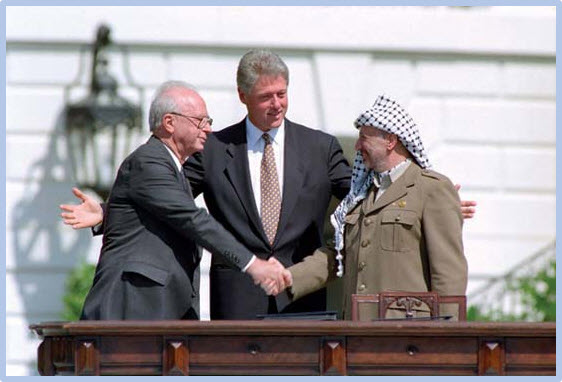
Rabin,
Clinton and Arafat:† 1993
Unit
Overview
Before
World War II, Arabs were generally united in opposing the colonial powers in
the Middle East and the migration of Jews to the Holy Land.† Britain granted independence to Egypt and
Iraq prior to the war, and the French gave similar rights to Syria and Lebanon
in 1945.† Palestine, however, was another
matter.† Both Palestinian Arabs and
Jewish settlers were determined to establish their own nations there.† When the British officially withdrew from the
area in 1948, they turned the problem over to the United Nations, who answered
by dividing Palestine into two states. The ensuing conflict has resulted in
wars, acts of terrorism and extensive efforts to find a peaceful solution.† Letís see how it all happened.
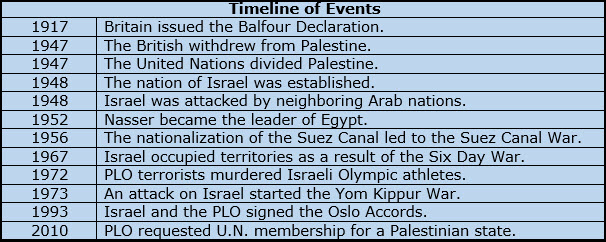
STOP:† Answer Section A Questions.
The
Growth of Zionism
Although
the political moves which led to the formation of Israel occurred in the
twentieth century, the return of Jews to the Holy Land gained momentum in the
late 1800s.† As anti-Semitism became increasing prevalent in Russia and Eastern
Europe, the number of violent attacks on Jewish citizens grew.† Reacting to the persecution, many Jews
thought that migration was the only way to ensure their safety and adopted the
political philosophy of Zionism, a
belief in the establishment of a Jewish-centered state in their ancestral
territory.† As the Zionist movement
spread, groups of Jews returned to the Middle East and began to build
agricultural settlements.† Prior to this
development, most Jews in the area lived in Jerusalem.† The outlying regions were primarily inhabited
by Arabs, who were Muslims.† Following
the turn of the century, Zionism gained support among many non-Jews.† This became apparent in 1917 when the British
government, in control of Palestine,
issued the Balfour Declaration.† In this document, Britain endorsed the
creation of a Jewish state in the Holy Land.†
This encouraged even more Jews to move to Palestine after World War
I.† Meanwhile, fascist regimes in Italy
and Germany fostered an alarming surge in anti-Semitism.

STOP:† Answer Section B Questions.
The
Division of Palestine
After
World War I, Britain governed Palestine in the form of a League of Nations mandate.† This meant that the British had temporary
administrative control over the region.†
Arabs and Jews expected the fulfillment of the promises made in the
Balfour Declaration, but this proved to be an impossible task.† As the Jewish population grew, Arabs staged
large-scale demonstrations in protest.†
The British tried to ease the tension by placing restrictions on the number
of Jews that could legally immigrate to Palestine.† This stranded many in Nazi Germany.† The situation became increasingly volatile,
and both sides resented the British.†
Exhausted from two world wars and financially drained, Britain withdrew
from Palestine in 1947 and turned the Palestinian question over to the United
Nations.
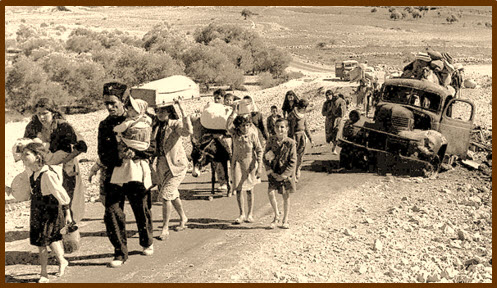
Palestinian Refugees Displaced by Israel
After
much discussion, the General Assembly passed a plan to divide the region into
two statesóone Jewish and the other Arab.†
This was acceptable to the Jews but not to the Arabs.† Nonetheless, when the British mandate
officially ended on May 14, 1948, the Jewish settlers proclaimed their lands as
the new nation of Israel.† A group of Arab countries immediately
attacked the Jewish state.† The Israelis
repelled the invasion and conquered additional territory.† Over 900,000 Arabs were forced to flee and
became refugees.† This displacement deepened the hostility of
the Arab states toward Israel and its allies, the United States and Great
Britain.† In 1964, various refugee groups
joined together to form the Palestine
Liberation Organization (PLO).
The
Arab defeat inspired a revolution in Egypt in 1952 and brought its leader, Gamal Abdel Nasser, to power.† His troops drove out Egyptís King Farouk, a corrupt, pro-Western
leader.† Then, Nasser became the
republicís deputy prime minister and proved adept at playing the superpowers
against each other.† In 1956, Nasser
infuriated the British and the French by nationalizing the European-owned Suez Canal Company.† These nations responded by joining forces
with the Israelis to invade Egypt and to retake control of the canal.† Although they overpowered the Egyptian
military in the Suez Canal War,
international pressure forced Israel and its allies to withdraw.† This elevated Nasserís status in the Arab
world and fueled the Pan-Arab Movement.† This idea encouraged political and cultural
unity among the Arab states.† However,
Arabs remained too divided to achieve this goal.† They could agree on little but their support
for Palestinian refugees and their opposition to Israel.
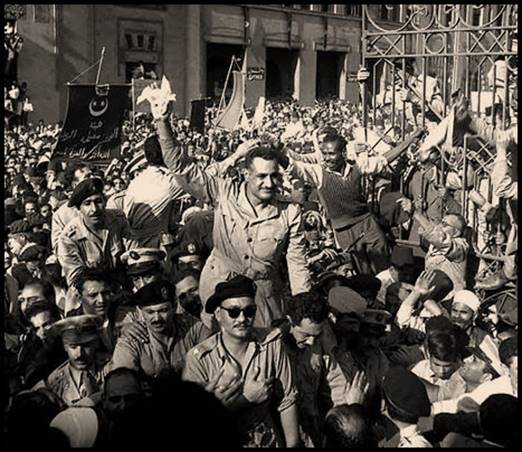
Gamal
Abdel Nasser:† 1954
Israel
defeated other attacks from neighboring Arab nations in 1967 and 1973.† The country also confronted random guerrilla warfare tactics and terrorist
activities.† As result of the Six Day War in 1967, Israel won the Gaza Strip and the Sinai Peninsula from Egypt. †The Jewish state also took the Golan Heights from Syria as well as the
West Bank and East Jerusalem from Jordan.†
The Israelis refused to give up these territories unless the Arab
nations recognized their right to exist.†
Eventually, Israel annexed the Golan Heights and East Jerusalem.† When settlers built homes on these occupied
lands, even more Palestinians were displaced.
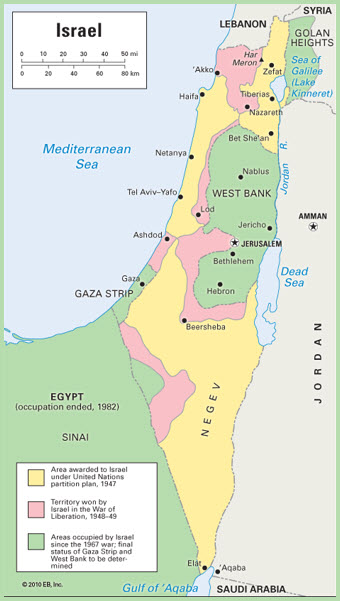
Support
for the PLO, led by Yasser Arafat,
increased proportionally with the number of refugees. Since the PLO believed
that Israel had no right to exist in Palestine, the destruction of the Jewish
state was the organizationís primary goal.†††
Airplane highjacks, bombings and the Munich Massacre, an event that resulted in the deaths of several
Israeli Olympic athletes, were part of the PLO strategy to gain recognition for
their cause.† These attacks also
strengthened the Israeli resolve not to negotiate with the PLO.† Beginning in the 1980s, young Palestinians
engaged in uprisings, known as intifadas,
to protest Israeli occupation.† Snipers
fired on Jewish soldiers.† Suicide
bombers killed and injured hundreds of civilians.† Israel responded with military force, and
thousands of Palestinians lost their lives and their homes.† Bitterness escalated on both sides.
STOP:† Answer Section C Questions
Peace
Efforts
Even
though the fighting continued, there were attempts to secure a peaceful
settlement.† In 1977, Egyptian president Anwar Sadat broke with Arab precedent
and made a visit to Israel.† This
breakthrough led to negotiations between Israel and Egypt under the direction
of U.S. President James Carter.† Although the agreement, referred to as the Camp David Accords, was limited, both
countries gained. Israel committed to the gradual return of the Sinai Peninsula
to Egypt by 1982, and Egypt established normal diplomatic relations with
Israel.† Because Israel retained the Gaza
Strip, however, some Palestinians regarded Sadatís initiative as treason, and
this led to his assassination in 1981. Israel managed to construct an agreement
with Jordan in the early 1990s, but
talks with the Syrians were
inconclusive.
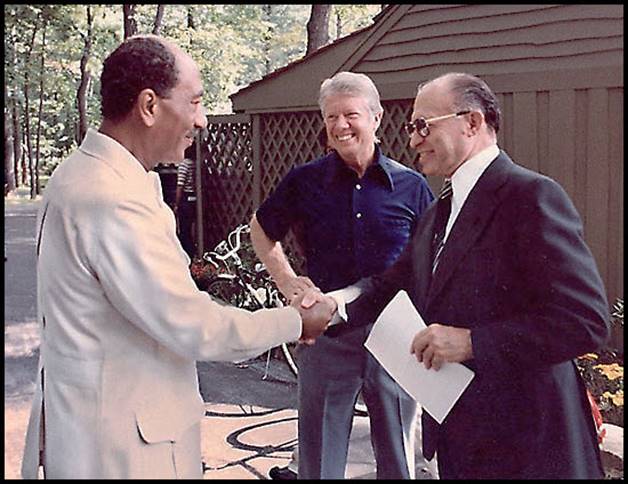
Anwar Sadat, Menachem
Begin and James Carter at Camp David:†
1978
The
PLO agreed to face-to-face talks with Israel concerning occupied territories in
1993.† This resulted in the Oslo Accords, an agreement signed by
Yasser Arafat and Yitzhak Rabin, the
Israeli Prime Minister.† Under its terms,
Israelis would gradually hand over the governmental functions of the West Bank
to a Palestinian council.† The Palestinian Authority, directed by
Yasser Arafat, would oversee the change.†
Israelis would be able to come and go freely, but security would be the
responsibility of the Palestinian police.†
In exchange, the PLO agreed to recognize Israelís right to exist.† Israelis began to withdraw their forces in
1994, and the first elections were held under the supervision of the
Palestinian Authority in 1996.† As
expected, Arafat was chosen as president, and his Fatah Party earned a majority in the Palestinian Legislative Council.†††
In 2003, the post of prime minister was added, and Mahmoud Abbas was the first person to hold that office.† Abbas also assumed the leadership of the PLO
after the death of Arafat in 2004.
Although
these were positive developments, the implementation of the Oslo Accords faced
strong opposition.† Palestinians were
disappointed that it did not create an independent Palestinian state, and many
Israelis did not want to give up territory that they had sacrificed to win.† Hamas,
Hezbollah and other radical Palestinian groups continued to carry out
terrorist attacks and reaffirmed their intent to destroy Israel.† As the number of suicide bombings increased,
Israelís fear and distrust of its Arab neighbors intensified.† When the United States pushed to restart the
peace process, efforts remained stalled.†
Since 2010, the Palestinian leadership had made international
recognition of a Palestinian state its priority.† Abbas asked the United Nationís Security
Council to recommend U.N. membership for an independent Palestinian state.† He argued that the American-led meetings did
not put equal pressure on Israel to make concessions.† No action was taken on this suggestion,
however, when the United States made it clear that it would veto the measure.†
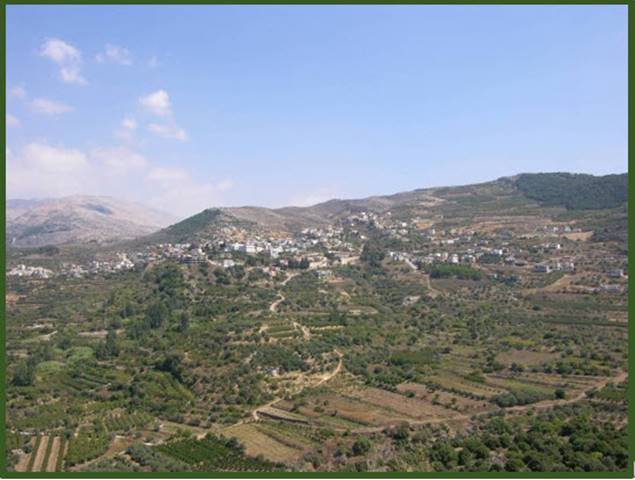
Jewish Settlements on the Golan Heights
Issues
continue to inhibit a peaceful solution to the Arab-Israeli conflict.† Many Israelis demand that an agreement
include permission to maintain their homes built in occupied territories.† Palestinians, on the other hand, want to
return to the lands traditionally held by their families before the wars.† Questions also surround the city of
Jerusalem.† It is has great religious
significance for Christians, Muslims and Jews.†
Palestinians want Muslims to have control over the Islamic holy places
in the city and to reserve East Jerusalem as the capital of the new Palestinian
state.† Jews and Christians are equally
determined that Jerusalem remain undivided.†
As long as both sides remain fully entrenched their own viewpoints,
peace continues to be difficult to achieve.
STOP:† Answer Section D Questions.
What
Does It All Mean?
Issues
continue to inhibit a peaceful solution to the Arab-Israeli conflict.† Many Israelis demand that an agreement
include permission to maintain their homes built in occupied territories.† Palestinians, on the other hand, want to
return to the lands traditionally held by their families before the wars.† Questions also surround the city of
Jerusalem.† It is has great religious
significance for Christians, Muslims and Jews.†
Palestinians want Muslims to have control over the Islamic holy places
in the city and to reserve East Jerusalem as the capital of the new Palestinian
state.† Jews and Christians are equally
determined that Jerusalem remain undivided.†
As long as both sides remain fully entrenched their own viewpoints,
peace continues to be difficult to achieve.

Additional Resources and Activities
Unit 20 Writing Exercises:†
Conflicts and Change in the Middle East
Unit 20 The Gaza Strip:†
A key point in the Israeli-Palestinian Conflict Article with Quiz